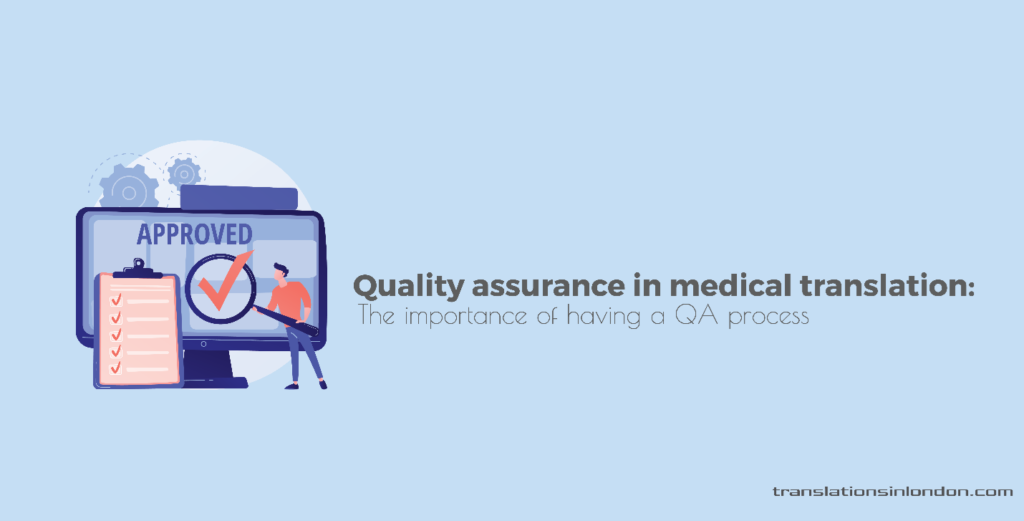
Almost all disciplines have an allowable margin for error in their operations, but we can’t say the same for the medical field.
This assertion particularly holds water when translating medical documents since we can always refer to the case where a single mistranslated word brought about a negatively bizarre outcome.
For this reason, medical service providers and other participants, asides from hiring the right professionals for all medical translation services, must also ensure that all translated or interpreted output passes through a quality assurance phase. This would help promote better standards and avoid problems that could result from erroneous or mistranslated medical information.
Errors in medical translation
We had earlier mentioned errors in medical translated texts, but what are these errors? How do they come about? And how can you mitigate them?
The answers to these questions are quite robust, but let us attempt to address them in the shortest possible forms.
For starters, errors in medical translation or interpretation could be in the form of; errors due to unqualified translators, ambiguous source text, lack of verification and quality assurance, and a host of other reasons.
That being said, we can all now agree that a fundamental understanding of the translation process and the types of errors commonly encountered makes it easier to suggest or reconcile the quality assurance process of your languages service provider.
Developing a QA process
Besides reconciling or suggesting a quality assurance process, the question of how to generate a QA system for medical translation arises.
But before going into that, every interested stakeholder needs to factor in some considerations.
- The choice of your language service provider: Rather than just narrowing your selection to who offers the most affordable service, look beyond pricing to which LSP offers your desired language pair and if they are certified to handle medical translations.
- The translators handling the project: At the risk of sounding paranoid, research into their professional qualifications and proficiency in both the source and target language(Native or near-native is most often desirable). You can even take it a step further by looking at their academic background. As a translator with medical training or medical professional with linguist training is more likely to create higher quality translation than one without.
When it comes to developing a QA process, keep in mind that the process needs to be robust to cover all the stages of the translation process and, at the same time, be efficient enough in order to detect errors.
You can develop a simple QA process for medical translation by following a few steps;
- Start by preparing the source material. Source text should be clear to the translator and free from ambiguity.
- Once the source text is done, proceed with a meaning by meaning translation of the document. Make sure that the output is grammatically accurate. In addition, scrutinize the output to ensure consistent and correct terminology, context, etc.
- Conduct a review of the translated material (By a qualified professional)
- Let a qualified third party proofread the reviewed output.
- Collect feedback from the client and translator to ensure that the final text is well-understood.
A quality assurance model for medical translation
Source: Researchgate
Importance of a Quality assurance process
Even though quality is crucial in the translation industry, it is particularly essential when translating or interpreting medical information due to its sensitive nature. Information can either be medical records, clinical trial protocols or even consent forms. Establishing that all information is free from errors and are clearly understood by the desired recipient is the fundamental aim of a QA process, but let us explore other reasons.
- It helps improve the quality of healthcare delivery
- QA makes the entire translation process more efficient
- Quality assurance protects medical stakeholders from the adversities of mistranslation
- It potentially helps to save cost associated with the re-translation of inaccurate information
Conclusion
Although it is virtually impossible to completely eliminate all forms of error when translating medical documents, it is quite possible to reduce them to a minimum. The road to doing so starts by first being able to identify the errors present and your LSP’s ability to develop a quality assurance process that facilitates its detection and subsequent removal.
That said, an excellent quality assurance process could be the difference between proper healthcare delivery and a medical disaster.
At Translationsinlondon, we have a team of professionally certified medical translators and interpreters with a quality assurance process designed to promote quality standards and eliminate errors in medical translation.